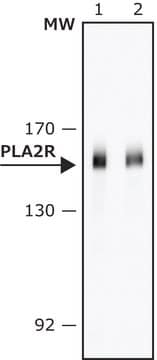F4516
Anti-Human IgG2−FITC antibody, Mouse monoclonal
clone HP-6014, purified from hybridoma cell culture
Synonim(y):
Monoclonal Anti-Human IgG2
About This Item
Polecane produkty
pochodzenie biologiczne
mouse
białko sprzężone
FITC conjugate
forma przeciwciała
purified from hybridoma cell culture
rodzaj przeciwciała
secondary antibodies
klon
HP-6014, monoclonal
Postać
buffered aqueous solution
warunki przechowywania
protect from light
metody
dot immunobinding: 1:32
particle immunofluorescence: 1:16
izotyp
IgG1
Warunki transportu
dry ice
temp. przechowywania
−20°C
docelowa modyfikacja potranslacyjna
unmodified
Szukasz podobnych produktów? Odwiedź Przewodnik dotyczący porównywania produktów
Opis ogólny
Specyficzność
Zastosowanie
Postać fizyczna
Przechowywanie i stabilność
Oświadczenie o zrzeczeniu się odpowiedzialności
Not finding the right product?
Try our Narzędzie selektora produktów.
Kod klasy składowania
10 - Combustible liquids
Klasa zagrożenia wodnego (WGK)
WGK 3
Temperatura zapłonu (°F)
Not applicable
Temperatura zapłonu (°C)
Not applicable
Środki ochrony indywidualnej
Eyeshields, Gloves, multi-purpose combination respirator cartridge (US)
Certyfikaty analizy (CoA)
Poszukaj Certyfikaty analizy (CoA), wpisując numer partii/serii produktów. Numery serii i partii można znaleźć na etykiecie produktu po słowach „seria” lub „partia”.
Masz już ten produkt?
Dokumenty związane z niedawno zakupionymi produktami zostały zamieszczone w Bibliotece dokumentów.
Klienci oglądali również te produkty
encephalitis associated with ovarian teratoma
Produkty
Zapoznaj się z kluczowymi czynnikami, które powinny mieć wpływ na decyzję o wyborze przeciwciała drugorzędowego. Dowiedz się więcej o gatunkach, podklasach, izotypach, etykietach i nie tylko.
Review the key factors that should figure in your decision to choose a secondary antibody. Learn about species, subclass, isotype, label, and more.
Nasz zespół naukowców ma doświadczenie we wszystkich obszarach badań, w tym w naukach przyrodniczych, materiałoznawstwie, syntezie chemicznej, chromatografii, analityce i wielu innych dziedzinach.
Skontaktuj się z zespołem ds. pomocy technicznej










